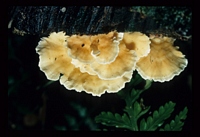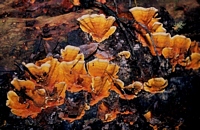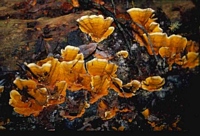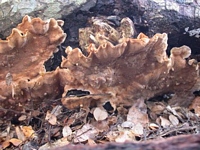|
 Stereum ostrea Stereum ostrea
SynonymsStereum fasciatum
Stereum lobatum
Thelephora lobata
Thelephora ostrea
Thelephora versicolor β Thelephora fasciata
Stereum australe
BiostatusPresent in region - Indigenous. Non endemic
Images (click to enlarge)
Caption: Day's Bay 25/4/1973
Owner: Herb. PDD | 
Caption: 1996
Owner: Peter Buchanan | 
Owner: P.K. Buchanan | 
Caption: Stereum ostrea
Owner: Nils Hallenberg | |
Article: Cunningham, G.H. (1963). The Thelephoraceae of Australia and New Zealand. New Zealand Department of Scientific and Industrial Research, Bulletin 145: 359 p. Wellington:.
Description: Hymenophore annual, or biennial, coriaceous, pileate, sessile. Pilei
commonly flabelliform or umbonate and attached by a narrow base,
caespitose-Imbricate when several develop from a common resupinate base, less
often applanate and dimidiate, sometimes effused-reflexed with a prominent
resupinate basal area, rarely cupulate or infundibuliform, occasionally wholly
resupinate when irregularly orbicular, 1-14 cm radius, 1-10 cm wide; pileus
surface at first clothed with tan or bay tomentum, soon sulcate and zoned either
with light and dark brown hairs, or zones in which the chestnut cortex is
exposed, sometimes almost naked near margins, points of attachment, or both,
often radiately crenulate or fluted; margins acute, plane, crenate, sometimes
deeply lobed and occasionally lacerated, concolorous; hymenial surface ochre or
pallid chestnut, showing similar concentric and/or radiate markings as the
surface, scantily creviced when old, or even. Context straw colour, 0.2-0.4 mm
thick, a dense layer of radiately arranged parallel hyphae, with a dense
coloured cortex beneath abhymenial hairs, some of which are encrusted with
granules of mucilage or often cemented into groups; skeletal hyphae 4-6 µm
diameter, walls 1.5-2 µm thick, hyaline or tinted yellow in areas beneath the
hymenium; generative hyphae 3-4.5 µm diameter, walls 0.5 µm thick, without clamp
connections. Cystidioid hyphae penetrating the hymeneal layer and projecting
slightly, with apices expanded to 8 µm, walls 2 µm thick, contents granular,
occasionally discoloured in herbarium specimens. Hymenial layer to 70 µm deep, a
dense palisade of basidia, paraphyses, and cystidioid hyphae. Basidia
subclavate, 20-25 x 4-5 µm, bearing 4 spores; sterigmata slender, erect, to 5 µm
long. Paraphyses subclavate or cylindrical, 16-20 x 3.5-4 µm. Spores narrowly
elliptical, obliquely apiculate, 5-6 x 2-2.5 µm, walls smooth, hyaline, 0.2 µm
thick.
Habitat: HABITAT: Solitary
or crowded on bark or decorticated wood of dead branches and trunks.
Distribution: DISTRIBUTION: Cosmopolitan.
Notes: Following examination of collections in Kew herbarium and the abundant
specimens available in Australia and New Zealand I am satisfied that S.
fasciatum, S. lobatum, and S. ostrea are merely forms of one
variable species. Types of S. perlatum ex Philippine Islands, S.
concolor from Tasmania, and a Kew collection labelled S.
leichkardtianum are also based on this one species. In the region are found
specimens similar to those upon which Burt (1920b, pp. 155, 163) attempted to
separate S. fasciatum from S. lobatum. According to latitude,
altitude, and age they exhibit varying growth conditions, from flabelliform
through effused-reflexed to resupinate, and degree of hairiness of the surface,
ranging from tomentose to almost naked. Typical plants are large, lobed, and
zoned with naked and tomentose concentric areas. Plants collected while young,
or from mountain areas, may be smaller, more hirsute, often effused-reflexed and
frequently resupinate. It is therefore not possible to maintain the two species
on macrofeatures, and in microfeatures they are identical. In a previous paper
(Cunningham, 1956b, p. 218) the species was described under the name of S.
lobatum. It appears that the most likely epithet for the species is S.
fasciatum, since this was the first applied valid name, so far as is at
present known, and the type is extant.
Article: Cooke, M.C. (1879). New Zealand fungi. Grevillea 8(46): 54-68.
Article: Cunningham, G.H. (1963). The Thelephoraceae of Australia and New Zealand. New Zealand Department of Scientific and Industrial Research, Bulletin 145: 359 p. Wellington:.
Description: Hymenophore annual, coriaceous, pileate,
sessile. Pilei commonly flabelliform or conchate, attached by a small umbo,
occasionally applanate with lateral edges inrolled, solitary or crowded, 1.5-4
cm radius, 2-5 cm wide; pileus surface densely tomentose, or even, lanate when
young, straw colour or dingy ochre, concentrically ridged and furrowed,
sometimes concentrically zoned with concolorous hairs, becoming denuded in
concentric areas exposing the chestnut cortex; hymenial surface at first
chestnut, drying cinereous, reddish where bruised, concentrically furrowed, or
even, at length deeply radiately creviced. Context isabelline, 0.3-0.8 mm thick,
a dense layer of radiately arranged parallel hyphae, bordered by a coloured
cortex of cemented parallel hyphae bearing the abhymenial hairs; skeletal hyphae
to 6 µm diameter, walls 1-1.5 µm thick; generative hyphae 2.5-3 µm diameter,
walls 0.2 µm thick, without clamp connections. Conducting hyphae modified from
skeletal hyphae, penetrating the hymenial layer but not projecting, inflated to
8 µm, walls 1-1.5 µm thick, contents orange. Hymenial layer to 85 µm deep, a
dense palisade of basidia, paraphyses, and conducting hyphae. Basidia
subclavate, 16-24 x 4-4.5 µm, bearing 4 spores; sterigmata slender, erect, to 5
µm long. Paraphyses cylindrical or subclavate, 12-20 x 3.5-4 µm. Spores
elliptical, apiculate, 4-6 x 3-3.5 µm, walls smooth, hyaline, 0.1 µm thick.
Habitat: HABITAT: Solitary or crowded
on bark of dead branches.
Distribution: DISTRIBUTION: North and South America, West Indies, Madagascar, South
Africa, Fiji, Australia.
Notes: Specimens agree with
authentic material from Madagascar examined in Kew herbarium. The species is
close to S. fasciatum in general appearance, especially surface
features, differing in colour of the hymenial surface, thicker context, broader
spores, and especially, presence of conducting hyphae. The last are modified
ends of skeletal hyphae containing orange contents which stain deeply. They
simulate cystidioid hyphae, differing in contents and greater abundance. When
fresh the hymenium if cut bleeds as in S. sanguinolentum. From the
latter the species differs in possessing a dimitic hyphal system, whereas in
most 'bleeders' the hyphal system is monomitic, conducting hyphae being modified
from generative hyphae. Occasional acanthophyses were noted in the Madagascar
collection, but are absent from specimens collected in this region.
|